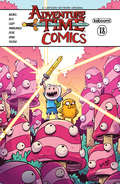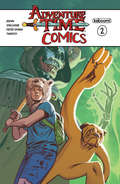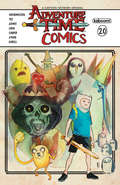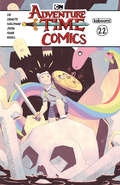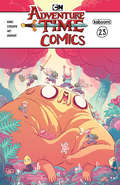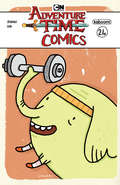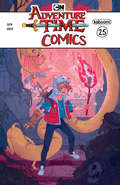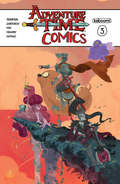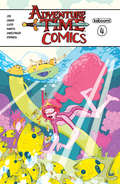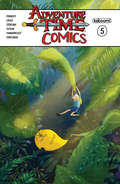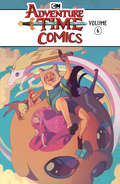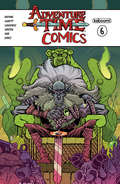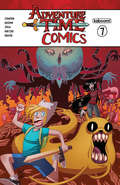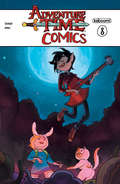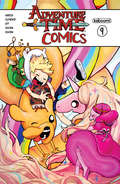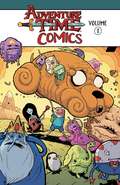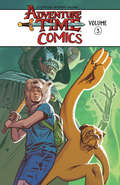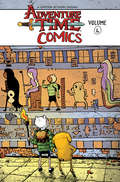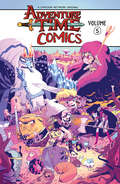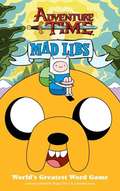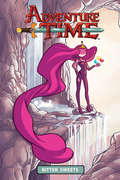- Table View
- List View
Adventure Time Comics (Adventure Time Comics #18)
by Pendleton Ward<p>Finn and Jake have way too much stuff! Turns out that years of looting dungeons and adventuring adds up. Time for the biggest yard sale in all of Ooo! <p>This is a fixed-format ebook, which preserves the design and layout of the original print book.</p> <P><P> <i>Advisory: Bookshare has learned that this book offers only partial accessibility. We have kept it in the collection because it is useful for some of our members. Benetech is actively working on projects to improve accessibility issues such as these.</i>
Adventure Time Comics (Adventure Time Comics #19)
by Pendleton Ward<p>Banana Man is on a race against time as his fish girlfriend, Sybil, is losing water fast! Can they make it to the pool party before Death does? <p>This is a fixed-format ebook, which preserves the design and layout of the original print book.</p> <P><P> <i>Advisory: Bookshare has learned that this book offers only partial accessibility. We have kept it in the collection because it is useful for some of our members. Benetech is actively working on projects to improve accessibility issues such as these.</i>
Adventure Time Comics (Adventure Time Comics #2)
by Pendleton Ward<p>Jake helps Finn with a treasure hunt but is trying to hurry it up so he can meet with his agent about his story pitch. Finn, Jake, & PB go on vacation in the Pastry Riviera, but Finn is anxious to fight evil & has trouble getting into a relaxed frame of mind. Billy gets saved by Finn and it turns into a comic that Finn is drawing. <p>This is a fixed-format ebook, which preserves the design and layout of the original print book.</p> <P><P> <i>Advisory: Bookshare has learned that this book offers only partial accessibility. We have kept it in the collection because it is useful for some of our members. Benetech is actively working on projects to improve accessibility issues such as these.</i>
Adventure Time Comics (Adventure Time Comics #20)
by James Asmus Daniel Bayliss Chase Van Weerdhuizen Jason Cooper Emei Burell Alexandra Beguez<p>Finn and Jake get a glimpse into their friends’ minds. Ooo tries to throw its first annual garage sale—and it does not end well. <p>This is a fixed-format ebook, which preserves the design and layout of the original print book.</p> <P><P> <i>Advisory: Bookshare has learned that this book offers only partial accessibility. We have kept it in the collection because it is useful for some of our members. Benetech is actively working on projects to improve accessibility issues such as these.</i>
Adventure Time Comics (Adventure Time Comics #21)
by Aaron McConnell Benjamin Marra Aleksandr Gushky<p>Finn and Jake are on a dungeon quest and Ricardio is back to find the love of his life! <p>This is a fixed-format ebook, which preserves the design and layout of the original print book.</p> <P><P> <i>Advisory: Bookshare has learned that this book offers only partial accessibility. We have kept it in the collection because it is useful for some of our members. Benetech is actively working on projects to improve accessibility issues such as these.</i>
Adventure Time Comics (Adventure Time Comics #22)
by Danielle Chenette Jamie Coe Reza Farazmand Brandon Zuern Carissa Powell Matt Frank Goncalo Lopes<p>Ooo is being invaded by dragons and Finn and Jake are the heroes for the job! All seems to be going well until Jake tries to disguise himself as a dragon. It goes… poorly. <p>This is a fixed-format ebook, which preserves the design and layout of the original print book.</p> <P><P> <i>Advisory: Bookshare has learned that this book offers only partial accessibility. We have kept it in the collection because it is useful for some of our members. Benetech is actively working on projects to improve accessibility issues such as these.</i>
Adventure Time Comics (Adventure Time Comics #23)
by Jack Sjogren Pendleton Ward Xiao Tong Kong Jean Wei Mari Arakaki<p>Finn and Jake are entrusted with the keys to the Breakfast Kingdom, which they will absolutely not lose in any way. <p>This is a fixed-format ebook, which preserves the design and layout of the original print book.</p> <P><P> <i>Advisory: Bookshare has learned that this book offers only partial accessibility. We have kept it in the collection because it is useful for some of our members. Benetech is actively working on projects to improve accessibility issues such as these.</i>
Adventure Time Comics (Adventure Time Comics #24)
by Tyler Jenkins Pendleton Ward<p>When bandits invade the Candy Kingdom and make off with a month’s supply of ice cream, it’s up to Finn and Jake to become the roughest, toughest cowboys in Ooo and rescue the stolen supplies. Written and illustrated by Grass Kings’ Tyler Jenkins! <p>This is a fixed-format ebook, which preserves the design and layout of the original print book.</p> <P><P> <i>Advisory: Bookshare has learned that this book offers only partial accessibility. We have kept it in the collection because it is useful for some of our members. Benetech is actively working on projects to improve accessibility issues such as these.</i>
Adventure Time Comics (Adventure Time Comics #25)
by Pendleton Ward<p>Finn and Jake are waiting at a bus stop, but they aren’t sure how they got there or who they are waiting for. <p>This is a fixed-format ebook, which preserves the design and layout of the original print book.</p> <P><P> <i>Advisory: Bookshare has learned that this book offers only partial accessibility. We have kept it in the collection because it is useful for some of our members. Benetech is actively working on projects to improve accessibility issues such as these.</i>
Adventure Time Comics (Adventure Time Comics #3)
by Pendleton Ward<p>This issue features three short stories headlining Detective Bubblegum, BMO, and Marceline! <p>This is a fixed-format ebook, which preserves the design and layout of the original print book.</p> <P><P> <i>Advisory: Bookshare has learned that this book offers only partial accessibility. We have kept it in the collection because it is useful for some of our members. Benetech is actively working on projects to improve accessibility issues such as these.</i>
Adventure Time Comics (Adventure Time Comics #4)
by Pendleton Ward<p>Jake keeps beating an unbeatable game, Finn's gettin' all crazy from sleep deprivation, and Jungle Princess observes the weirdos passing through her kingdom. <p>This is a fixed-format ebook, which preserves the design and layout of the original print book.</p> <P><P> <i>Advisory: Bookshare has learned that this book offers only partial accessibility. We have kept it in the collection because it is useful for some of our members. Benetech is actively working on projects to improve accessibility issues such as these.</i>
Adventure Time Comics (Adventure Time Comics #5)
by Pendleton Ward<p>Ice King goes on a Wizard's Quest to gain ultimate power, Cake tries to make Fionna a special present, and Finn gets a new pet that is really uncool. <p>This is a fixed-format ebook, which preserves the design and layout of the original print book.</p> <P><P> <i>Advisory: Bookshare has learned that this book offers only partial accessibility. We have kept it in the collection because it is useful for some of our members. Benetech is actively working on projects to improve accessibility issues such as these.</i>
Adventure Time Comics (Adventure Time Comics #6)
by Jack Sjogren Matt Frank Sonny Liew Adam GorhamWHAT CAN OOO DO? Strange peril strikes the beloved world of Ooo again and no citizen is safe! Between Ice King’s heart calling it quits, to the entire Breakfast Kingdom getting locked out of their homes when Finn and Jake drop the key to the city in the Cappuccino River, mystery and chaos ensue in this ADVENTURE TIME COMICS collection. Featuring work by Sonny Liew, Matt Frank, Cristina Rose Chua, Jack Sjogren and many more! <P><P> <i>Advisory: Bookshare has learned that this book offers only partial accessibility. We have kept it in the collection because it is useful for some of our members. Benetech is actively working on projects to improve accessibility issues such as these.</i>
Adventure Time Comics (Adventure Time Comics #6)
by Pendleton Ward<p>Gunther tells his favorite story, and Finn and Jake have to fight monsters. <p>This is a fixed-format ebook, which preserves the design and layout of the original print book.</p> <P><P> <i>Advisory: Bookshare has learned that this book offers only partial accessibility. We have kept it in the collection because it is useful for some of our members. Benetech is actively working on projects to improve accessibility issues such as these.</i>
Adventure Time Comics (Adventure Time Comics #7)
by Pendleton Ward<p>Gunter tells us his favorite story, Choose Goose gets some sweet kicks, and Finn needs to find out what's wrong with Jake's diet! <p>This is a fixed-format ebook, which preserves the design and layout of the original print book.</p> <P><P> <i>Advisory: Bookshare has learned that this book offers only partial accessibility. We have kept it in the collection because it is useful for some of our members. Benetech is actively working on projects to improve accessibility issues such as these.</i>
Adventure Time Comics (Adventure Time Comics #8)
by Pendleton Ward<p>It's a special Fionna and Cake issue by New York Times bestseller Mariko Tamaki (This One Summer)! Marshall Lee and LSP need to figure out Marshall Lee's musical identity. <p>This is a fixed-format ebook, which preserves the design and layout of the original print book.</p> <P><P> <i>Advisory: Bookshare has learned that this book offers only partial accessibility. We have kept it in the collection because it is useful for some of our members. Benetech is actively working on projects to improve accessibility issues such as these.</i>
Adventure Time Comics (Adventure Time Comics #9)
by Pendleton Ward<p>In this issue's short stories, Choose Goose is the worst, Princess Bubblegum just wants to have a nice picnic, and Ooo is definitely a weird place. <p>This is a fixed-format ebook, which preserves the design and layout of the original print book.</p> <P><P> <i>Advisory: Bookshare has learned that this book offers only partial accessibility. We have kept it in the collection because it is useful for some of our members. Benetech is actively working on projects to improve accessibility issues such as these.</i>
Adventure Time Comics Volume 1 (Adventure Time Comics #1 - 4)
by Pendleton Ward<p>WHAT TIME IS IT?! It's Adventure Time Comics time! C'mon and grab your friends for this amazing collection of short stories from cartoonists all over the world. Featuring the amazing talent of Katie Cook (My Little Pony), Art Baltazar (Tiny Titans), Tony Millionaire (Maakies and the Sock Monkey), Box Brown (Andre the Giant) and many, many more. These sweet shorts come in many shapes and sizes, featuring all of the beloved characters from the Land of Ooo. Collects issues #1-4 of the new ongoing series. <p>This is a fixed-format ebook, which preserves the design and layout of the original print book.</p> <P><P> <i>Advisory: Bookshare has learned that this book offers only partial accessibility. We have kept it in the collection because it is useful for some of our members. Benetech is actively working on projects to improve accessibility issues such as these.</i>
Adventure Time Comics Volume 2 (Adventure Time Comics #5 - 8)
by Pendleton Ward<p>It's Adventure Time Comics time! These sweet shorts come in many shapes and sizes, featuring all of the beloved characters from the Land of Ooo, written and illustrated by acclaimed cartoonists and storytellers from all over the world. Presented in the artist's own style, each story captures the creativity that Adventure Time inspires! Featuring work by Derek Fridolfs (Study Hall of Justice), Zachary Sterling (Adventure Time), Riley Rossmo (Batman), Kyla Vanderklugt (Storyteller: Witches), Roger Langridge (The Baker Street Peculiars, Snarked), and many more! Collects issues #5-8 <p>This is a fixed-format ebook, which preserves the design and layout of the original print book.</p> <P><P> <i>Advisory: Bookshare has learned that this book offers only partial accessibility. We have kept it in the collection because it is useful for some of our members. Benetech is actively working on projects to improve accessibility issues such as these.</i>
Adventure Time Comics Volume 3 (Adventure Time Comics #9 - 12)
by Pendleton Ward<p>It's ADVENTURE TIME COMICS time! These sweet shorts come in many shapes and sizes, featuring all of the beloved characters from the Land of Ooo, written and illustrated by acclaimed cartoonists and storytellers from all over the world. These stories are in the artist's own style and capture the creativity that ADVENTURE TIME inspires! Featuring work by Jorge Corona (Feathers, We Are Robin), Cole Ott (Dare House), Eva Cabrera (Kim & Kim) and many more! Collects issues #9-12. <p>This is a fixed-format ebook, which preserves the design and layout of the original print book.</p> <P><P> <i>Advisory: Bookshare has learned that this book offers only partial accessibility. We have kept it in the collection because it is useful for some of our members. Benetech is actively working on projects to improve accessibility issues such as these.</i>
Adventure Time Comics Volume 4 (Adventure Time Comics #13 - 16)
by Phillip Kennedy Johnson<p>Dive into mathematical shorts from across the the Land of Ooo, written and illustrated by acclaimed writers and artists from around the world. Collects issues #13-16. <p>This is a fixed-format ebook, which preserves the design and layout of the original print book.</p> <P><P> <i>Advisory: Bookshare has learned that this book offers only partial accessibility. We have kept it in the collection because it is useful for some of our members. Benetech is actively working on projects to improve accessibility issues such as these.</i>
Adventure Time Comics Volume 5 (Adventure Time Comics #17 - 20)
by Pendleton Ward<p>Don’t miss out on this fun collection of stories based off of Cartoon Network’s hit show ADVENTURE TIME, featuring work by Jeffrey Brown (Darth Vader and Son), Michael Moreci (Superman), Christopher Mitten (American Vampire) and many more! Collects issues #17-20. <p>This is a fixed-format ebook, which preserves the design and layout of the original print book.</p> <P><P> <i>Advisory: Bookshare has learned that this book offers only partial accessibility. We have kept it in the collection because it is useful for some of our members. Benetech is actively working on projects to improve accessibility issues such as these.</i>
Adventure Time Crafts
by Cartoon Network Chelsea BloxsomWith Jake the dog and Finn the human, the crafts will never end! Learn how to stitch, paint, sculpt, and crochet more than 23 projects featuring your favorite Adventure TimeTM characters. You'll find designs by fans just like you for plush toys, chic jewelry, crafty home decor, and stylish fashions straight from the Candy Kingdom:* Reversible Jake/Cake Plush* Marceline's Axe* Bubblegum's Like-Like Sweater* Peppermint Butler Pillow* Oh My Glob, Nail Art!* Fionna and Finn Hats* BMO's 8-Bit Fuse Bead CoastersAnd so much more! What the lump are you waiting for? It's time to D.I.Y.!
Adventure Time Mad Libs
by Roger Price Leonard SternFill in the blanks with Finn and Jake! Adventure Time Mad Libs is based on the popular Cartoon Network show starring Finn, a silly kid with an awesome hat, and his dog Jake! Our book features 21 hilarious stories set in the mystical Land of Ooo that are sure to keep you laughing!
Adventure Time Original Graphic Novel: Bitter Sweets (Planet of the Apes #4)
by Pendleton Ward Kate Leth Zachary Sterling<p>It's that lovely time of year where Princess Bubblegum gets to leave the Candy Kingdom and venture out into the outer limits of Ooo. But when her annual quest to visit old friends takes a dark and unexpected turn, it's up to PB and Peppermint Butler to keep the peace by using the true power of friendship. <p>This is a fixed-format ebook, which preserves the design and layout of the original print book.</p> <P><P> <i>Advisory: Bookshare has learned that this book offers only partial accessibility. We have kept it in the collection because it is useful for some of our members. Benetech is actively working on projects to improve accessibility issues such as these.</i>
